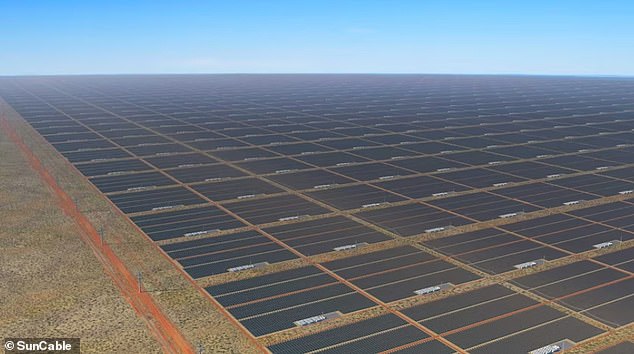Australia’s largest solar farm has been approved, with the potential to power three million homes, many of them located in a foreign country.
The Sun Cable Australia-Asia power link is expected to generate 4GW of renewable energy via a solar farm in the Northern Territory, creating more than 14,000 jobs.
The 12,000-hectare solar farm, which is backed by Atlassian billionaire Mike Cannon-Brookes, will be built on a former pastoral station between Elliott and Tennant Creek.
The approval given on Wednesday by federal Environment Minister Tanya Plibersek includes an 800-kilometre transmission line to Darwin and a subsea cable to the end of Australian waters.
The project will boost the Northern Territory’s economy by creating 14,300 jobs and elevating Australia’s renewable energy status globally, Plibersek said.
“It will be the largest solar park in the world and will position Australia as a global leader in green energy,” Plibersek said.
‘Australians have a choice between a renewable energy transition that is already underway, creating jobs and driving down prices, or paying for an expensive nuclear fantasy that may never be realised.’
She said the project would deliver nearly six times more energy than a large 700-megawatt nuclear reactor could deliver, criticizing what she called “an expensive nuclear fantasy” promoted by the federal opposition.
Sun Cable’s Australia-Asia power link is expected to generate 4GW of renewable energy via a solar farm in the Northern Territory, creating more than 14,000 jobs.

The 12,000-hectare solar farm, which is backed by Atlassian billionaire Mike Cannon-Brookes (pictured), will be built on a former pastoral station between Elliott and Tennant Creek in the Northern Territory.
“We have no idea what the equivalent of (Opposition Leader) Peter Dutton’s anti-renewables nuclear plan might be because there are no details beyond that it is too slow and too expensive,” he said.
The Sun Cable project had initial backing from billionaires Cannon-Brookes and Andrew Forrest, with the former winning the battle to acquire it after it was placed into voluntary administration in January 2023.
The two had disagreed over whether the project’s planned electricity transmission to Singapore was viable, and Cannon-Brookes was confident it was.
Cannon-Brookes’ private equity firm, Grok Ventures, injected $65 million into the company while it was under administration.
The project will have two stages.
The first will aim to deliver up to 4 GW of renewable energy to industrial customers in Darwin, including 900 MW in the first phase.
The second will aim to supply 1.75 GW of electricity to Singapore via a 4,200km-long undersea cable, a proposal that has been criticised by many for being overly ambitious.
The longest undersea link proposed so far is a fifth of the size: the 767km Viking link between the UK and Denmark.
But Cannon-Brookes responded to such criticism last year, saying the ambition is “proportionate to the challenges and opportunities of the transition to renewable energy”.
“While I recognize that some people might think it’s overly ambitious, we don’t think it is,” he said at the time.
“The truth is that the technology already exists to make this happen. We have every confidence that modern cable technology can reliably transport more electricity over greater distances and through deeper waters than was possible in the past,” he added.
However, there is still a long way to go.
A final decision on investment in the project is not expected to be made until 2027, with electricity supply planned to begin in the early 2030s.

